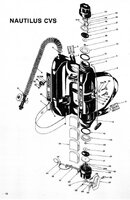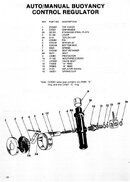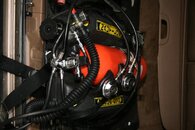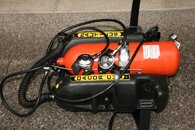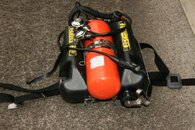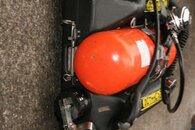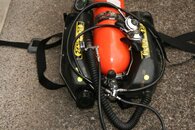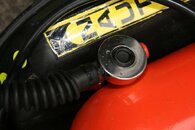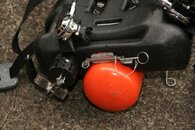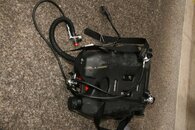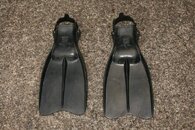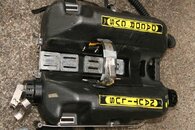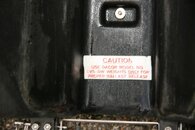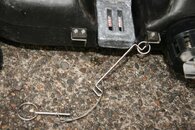ZKY,
In concept, they are not too bad; in reality, they are pretty bulky. I decided yesterday to take my Dacor Nautilus to the Clackamas River for a dive. Unfortunately, my steel 72 was in the shop for a hydro, and my other had only 1000 psig in it. So I decided to take my USD single 52 cf tank. It is a bit buoyant, but I figured that the Nautilus CVS with weights would overcome that. I could only find 3 of the 4 weights I normally use. I also had to take the tank boot off the tank (this is also necessary for the single 72; the system is really designed around a single AL 80 system). But I got it all figured out, and decided to wear a 10 pound weight belt too. I was diving my full wet suit with boots, hood and gloves (the water is pretty cold right now--in the 40s F).
The day here was pretty nice, with the sun peaking through clouds. I drove to the site in the small town of Gladstone, on the outskirts of Portland, OR. The High Rocks site is where I do most of my diving. It took me a few minutes to struggle into my wet suit, then assemble the gear and put it on. I put on a White Stag front-mount BC too, as it had a line to the front pocket which had a whistle attached. What is nice is that I could attach my car's key to that line, and have it. I also wanted to test the positioning of the "unconscious diver" with both the front-mount BC and the Nautilus with full inflation. I always wear a yellow helmet with my snorkel attached, and I wore a Dacor 3-window mask with a
SeawiscopeEY attached. A friend I met in Hong Kong, CY Tang, developed this device, and I have found it great for looking at small animals in the Clackamas River. I also dove my White Stage SuperStag fins for the first time. My regulator was a Dacor Pacer, and I had my Suunto Cobra attached to get a dive profile (unfortunately, the computer attachment is not working, so that will have to wait).
After completely gearing up, I proceeded to the dive spot at the head of High Rocks, put on my fins, mask with the SeawiscopeEY, helmet and gloves, and bent down to flood the Dacor Nautilus CVS. That flooding process took about fifteen seconds, and involves opening the valve on the bottom, and pushing up on the lever to open the top valve. I also tried the manual release on the hose, but had a few problems because of my gloves.
With the Nautilus flooded, I surface dived out into the current, and swam to the bottom. The freshwater sponge was still on the rocks, but was starting to break apart, loosing its green color and its outer parts, and readying itself for winter. Small Chinook salmon smolt were in the river, and I noted fishing gear for salmon and a few lead weights for line in the water. The Nautilus handled pretty well in the water, and my weight was pretty well balanced because of the weights in the unit's slide area (see the photos below). I swam across the river, and then under a main current on the surface (mini-rapid) into calmer water just downstream. I then swam cross-current toward the other bank, on a route I normally take in the summer. I noted that my octopus, which I had on a neck strap, was not in the correct position and inhibiting my movement somewhat, so I removed the neck strap and let it hang for the rest of the dive. I looked at my dive computer, and found that with the Nautilus it was just a bit too short to see comfortably, even with the SeawiscopEY. The Nautilus keeps the tank off my back by about two inches, and the lines need to be placed just right or they don't reach (my other gauges did not have this problem). I also noted that my weights were just about right, if actually a bit light. I picked up two rocks just to see, and this made me about right at the five-foot depth. I had swam downstream into an eddy current, which was taking me back up toward that rapid. When I got there, I put down the rocks, and let the current take me to the other side again, then into the main downstream current to get to the deeper hole.
As I drifted with the current, I made my may down into the deeper water where I normally need a fairly good amount of additional buoyancy to be neutral. But with only three of the four normal 3 pound weights in the weight area of the Nautilus, I needed only a minimal amount of buoyancy. I ascended a bit, and was going to try dumping air by opening the valve, then pushing up on the dump valve handle. As I was doing so, I began ascending, and could not dump the air fast enough to stop until I was at the surface. Here, I was dumping air in the traditional fashion, and because the bottom valve was open, this became a variable volume system. Had I kept the bottom valve closed, I would not have ascended, but also would not have been able to dump the air. I went back down and did it the right way, by grabbing some rebar and then opening the valve to dump air (yes, there is rebar on the river bottom).
With that experiment over, I started using the SeawiscopeEY to observe fish. There was a very large sculpin almost a foot long which would not budge (these guys own the bottom, and challenge divers when they come by. I watched him at very close quarters for maybe five minutes, then looked at a crayfish hanging onto the rock sides and walking down toward the bottom.
About this time, I noticed that my breathing was a bit harder, and looked at my gauge; I was getting low on air. So I reached around to activate my J-valve. I had purposely put it in the "On" position just to see how things would go. Well, it is very hard to reach the J-valve lever using the Nautilus, as it is on top, and around the Nautilus' buoyancy chamber. I had to get my thumb into a very awkward position to find it (especially with gloves on) and activate the J-reserve. I would not recommend this reserve be used by anyone after this experience; the gauge is better.
Now on reserve air, I swam across the river about twenty feet, then ascended the rock wall from the deep hole. On the surface, I opened the lower valve and completely filled the chamber with air. This gave me the 62 pounds of buoyancy (minus my twenty-four pounds of weight in the weight chamber and my belt, plus an additional 5 pounds on the Nautilus' waist strap). So I was floating pretty high in the water, with the system trying to push me over on my face. When it did so, it was easy to snorkel. Flipping onto my back took a bit of effort, but once there I was pretty high in the water. I inflated my vest orally, and then went limp. The Nautilus with the vest put me on my side with my mouth out of the water. I deflated the vest, and swam upstream to a place where there was a rock platform for exiting.
Once on that platform, I took off my White Stage fins (which took a bit of maneuvering with my gloves on) and threw them up onto the rock (which at this part was level. I then got my footing, and climbed out of the river on all fours (it's easier that way, with a lot of slick rock under my feet). I went to stand up, and then started walking toward the path (its a rock climb up there). Well, the tank was not secure enough, and slipped its mooring forcing me to remove the Nautilus, gather the weights, and start over putting it back on. I lifted the reassembled unit onto a rock, and a fisherman coming down the rock asked me to give him room to walk down the vertical rock (I had the Nautilus on a ledge). I asked him for a bit of patience, as I was putting the unit on my back. He waited, and I got it back on my back.
It was then simply a trek back up to the car. That is part of my workout routine, and with all that gear it is a good heart-rate workout. I finally made it up to the car (it's about an 80 foot climb), and put the Nautilus down in the back of my Honda Pilot (see the first photo, which is sideways). I drove back home, and after brunch got the gear out and took the photos below. They show the major components, and how it is rigged up.
I probably won't be diving the Nautilus again any time soon, as I would have preferred to have worn my twin 45s with a double hose regulator. I had to cut this dive short (only 15-20 minutes underwater), and exit early. I normally drift almost 1/4 mile downstream, and get out at a different location. But I did learn more about the Nautilus. I will be molding Dacor weights for it sometime (I have the mold), and not rely upon the weight belt weights (which work, but are not ideal and weigh a pound less). But it is bulky, even bulkier than my twins, and I prefer my Para-Sea BC to the Nautilus. But it did give me the opportunity to relate this adventure to you, and get some photos for you to see of this unique system, the Dacor Nautilus Constant Volume System.
SeaRat




